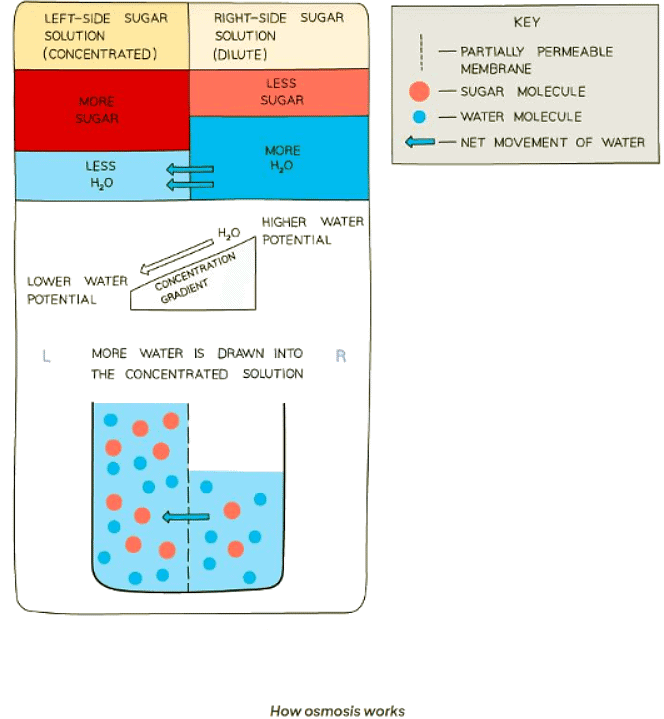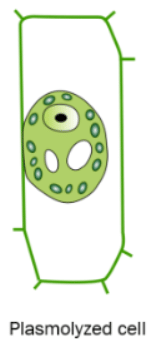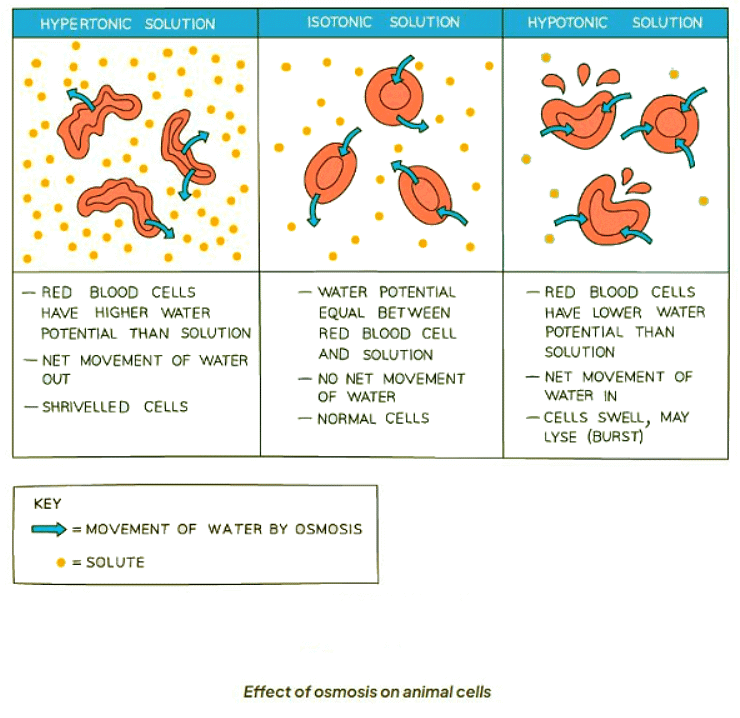Class 10 Exam > Class 10 Notes > Biology for GCSE/IGCSE > Osmosis in Animals & Plants
Osmosis in Animals & Plants | Biology for GCSE/IGCSE - Class 10 PDF Download
Osmosis in Plant Tissues
- When water moves into a plant cell, the vacuole enlarges, exerting pressure on the cell membrane against the cell wall
- The influx of water through osmosis results in the cell becoming sturdy and rigid
- This rigidity is vital for plants since it collectively provides support and fortitude, enabling the plant to stand upright with its leaves exposed to sunlight
- The cell wall's pressure regulates excessive water intake, preventing the cell from bursting
- Insufficient water intake causes the cells to lose their rigidity, resulting in wilting of the plant
Osmosis: Extended
- Osmosis entails the directional movement of water molecules from an area of higher water potential (a dilute solution) to one of lower water potential (a concentrated solution) through a partially permeable membrane.
- To avoid confusion between the concentration of water and the concentration of solute, we can describe a dilute solution as having a high water potential (illustrated on the right-hand side of the diagram below), while a concentrated solution has a low water potential (depicted on the left-hand side of the diagram below).

Question for Osmosis in Animals & PlantsTry yourself: What happens to a plant cell when water moves into it through osmosis?View Solution
Osmosis in Animals & Plants: Extended
Plant cells in solutions of different concentrations
- Placing plant cells in a solution with a higher water potential than inside the cells, such as distilled water, results in the influx of water into the plant cells via osmosis.
- As water molecules enter the cells, they exert pressure against the cell membrane, which in turn pushes against the cell wall, causing the cells to become turgid.

- Placing plant cells in a concentrated solution, where the external water potential is lower than inside the cells, results in the outward movement of water molecules through osmosis. This causes the plant cells to become flaccid.
- Flaccid plant cells can compromise the plant's structural support.
- Under a microscope, plasmolysis can be observed in the plant cells, indicating that the cell membrane has detached from the cell wall.

Animal cells in solutions of different concentrations
- Osmosis also impacts animal cells, leading to water loss or gain.
- Unlike plant cells, animal cells lack a rigid cell wall, making them more vulnerable to osmotic changes.
- Placing an animal cell in a hypertonic solution, with a lower water potential, causes water to exit the cell, resulting in crenation or cell shrinkage.
- Conversely, immersing an animal cell in a hypotonic solution, with a higher water potential, prompts water influx. Without a supportive cell wall, the cell membrane stretches until it reaches a breaking point, causing cell rupture.

The document Osmosis in Animals & Plants | Biology for GCSE/IGCSE - Class 10 is a part of the Class 10 Course Biology for GCSE/IGCSE.
All you need of Class 10 at this link: Class 10
|
110 videos|210 docs|33 tests
|
FAQs on Osmosis in Animals & Plants - Biology for GCSE/IGCSE - Class 10
| 1. How does osmosis work in plant tissues? |  |
Ans. Osmosis in plant tissues involves the movement of water molecules from an area of high water concentration to an area of low water concentration across a semi-permeable membrane, such as the cell wall or cell membrane.
| 2. How do plant cells utilize osmosis? |  |
Ans. Plant cells use osmosis to regulate the balance of water and nutrients within the cell. By controlling the movement of water molecules through osmosis, plant cells can maintain turgor pressure and support their structure.
| 3. How does osmosis differ between plant cells and animal cells? |  |
Ans. Plant cells have a rigid cell wall that allows them to resist excessive water uptake through osmosis, while animal cells do not have a cell wall and can burst if too much water enters through osmosis.
| 4. What is the effect of osmosis on animal cells? |  |
Ans. Osmosis can cause animal cells to swell and potentially burst if they absorb too much water. This can lead to cell damage and disruption of normal cell functions.
| 5. How does osmosis impact the overall health and function of animals and plants? |  |
Ans. Osmosis plays a crucial role in maintaining the hydration and structural integrity of both animal and plant cells. It helps regulate the movement of water and nutrients, ensuring proper functioning and survival of the organisms.
Related Searches




















